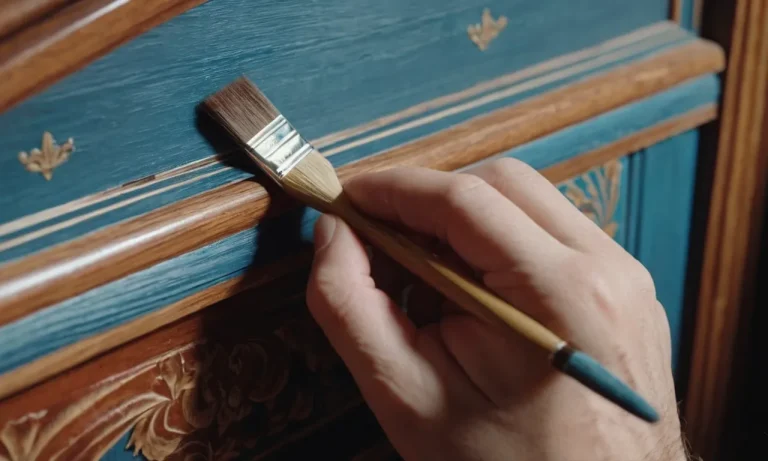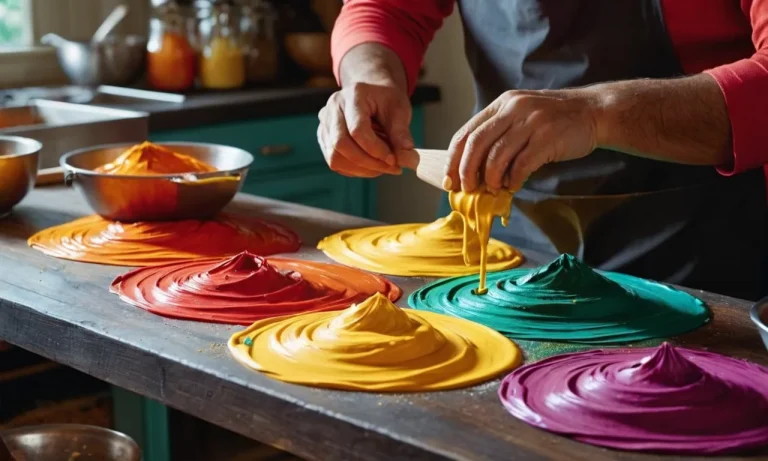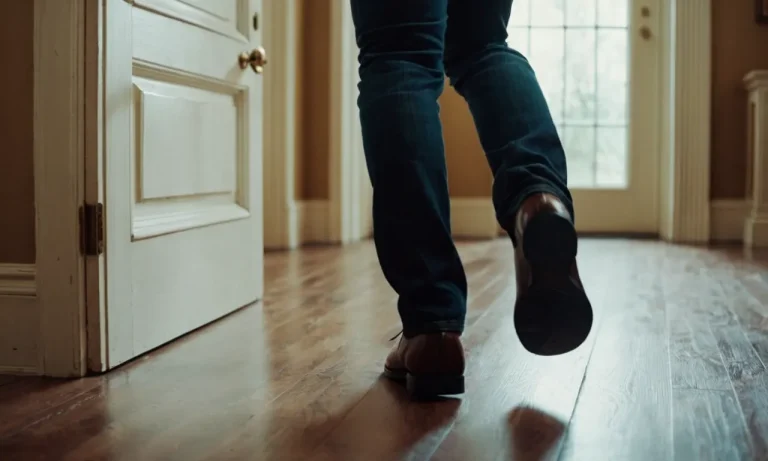Does Acrylic Paint Need Water? A Detailed Guide
Acrylic paint is a popular medium for artists of all levels. But a common question arises – does acrylic paint need water? The quick answer is yes, acrylic paint does need water. Unlike oil paints, acrylics require water to thin the paint and allow it to flow properly.
However, the amount of water you add can vary depending on the effects you want to achieve.
In this comprehensive guide, we’ll cover everything you need to know about using water with acrylics. We’ll discuss how water impacts acrylic paint, how much water to use, techniques for adding water, and tips for getting the right consistency.
How Water Impacts Acrylic Paint
Water plays a crucial role in working with acrylic paint. It can have several effects on the paint and how it behaves on the canvas. Let’s take a closer look at how water impacts acrylic paint.
Thins the paint
Adding water to acrylic paint can help thin it out, making it easier to apply and manipulate. This is particularly useful when you want to create translucent washes or build up layers of color. By diluting the paint with water, you can achieve a more fluid consistency that spreads smoothly across the surface.
Allows blending and smoothing
Water also facilitates blending and smoothing of acrylic paint. When mixed with water, acrylics become more workable and can be easily blended together to create smooth transitions between colors. This is especially beneficial when you want to achieve gradient effects or soften harsh edges.
Extends drying time
Another advantage of using water with acrylic paint is that it extends the drying time. Adding water slows down the evaporation of water from the paint, giving you more time to work with it before it dries.
This can be particularly helpful when working on larger projects or when you want to create intricate details without the paint drying too quickly.
Impacts finish and transparency
The amount of water you add to acrylic paint can also affect its finish and transparency. Adding more water can make the paint more translucent and increase its transparency, allowing underlying layers to show through.
On the other hand, using less water can result in a more opaque finish, covering up underlying layers.
It’s important to note that the impact of water on acrylic paint may vary depending on the brand and quality of the paint. Some paints are formulated to be more resistant to water, while others may require more water for optimal performance.
Experimenting with different ratios of paint and water will help you achieve the desired effects.
If you’re interested in learning more about acrylic paint and its properties, you can visit Winsor & Newton’s website for additional information and resources.
How Much Water to Use
When using acrylic paint, it is common to wonder how much water to use. Water is often added to acrylic paint to thin it out and create different effects. Here are some guidelines to help you determine the right amount of water to use:
Start with small amounts
When first adding water to acrylic paint, it is best to start with small amounts. This allows you to gradually adjust the consistency of the paint without adding too much water all at once. Start by adding a few drops of water and mix it thoroughly into the paint.
Assess the consistency and add more water if needed.
Add water sparingly
Acrylic paint is already water-based, so you don’t need to add a lot of water to achieve the desired consistency. Adding too much water can make the paint too thin and watery, affecting its ability to adhere to the surface properly.
It is recommended to add water sparingly, a few drops at a time, until you reach the desired consistency.
Too much water can ruin paint
While water can be used to thin out acrylic paint, it is important not to add too much. Adding excessive amounts of water can result in the paint losing its vibrancy and opacity. The colors may appear washed out, and the paint may not adhere well to the surface.
It is crucial to find the right balance and avoid adding too much water, especially if you want to achieve bold and vibrant colors.
Remember, the amount of water needed may vary depending on the brand of acrylic paint and the desired effect you want to achieve. It is always a good idea to experiment and test different amounts of water on a small surface before applying it to your actual artwork.
For more detailed information on using water with acrylic paint, you can visit reputable art websites like Art is Fun or ThoughtCo.
Techniques for Adding Water
When working with acrylic paint, adding water can be an effective technique to achieve different effects and manipulate the paint consistency. Here are several techniques for adding water to your acrylic paint:
Wet palette
A wet palette is a useful tool for keeping your acrylic paint moist and workable for extended periods of time. It consists of a palette with a layer of water at the bottom and a semi-permeable membrane on top.
By adding water to the palette, you can keep your paint from drying out too quickly while you work. This technique is especially useful for artists who require long working times or are working on large-scale projects.
Spray bottle
Using a spray bottle filled with water is another way to add moisture to your acrylic paint. By lightly misting the paint surface, you can keep it wet and workable. This technique is particularly useful when you need to rehydrate dried paint on your palette or on your canvas.
Just be mindful not to overspray, as too much water can cause the paint to become too diluted.
Directly on paint surface
If you want to thin your acrylic paint or create a more transparent effect, you can add water directly to the paint surface. Start by dipping your brush into water and then mix it with the paint on your palette.
This technique allows for precise control over the amount of water added and is commonly used for glazing or creating washes. Remember to gradually add water to avoid over-thinning the paint.
Mediums instead of water
While water is commonly used to thin acrylic paint, there are also various mediums available that can achieve similar effects. Acrylic mediums are specifically designed to alter the characteristics of acrylic paint, such as viscosity, drying time, and transparency.
Examples of acrylic mediums include gel mediums, flow improvers, and extender mediums. These mediums can be used instead of water or in combination with it to achieve different effects.
Remember, the amount of water or medium you add to your acrylic paint will depend on the desired consistency and effect you are trying to achieve. It is always a good idea to experiment and practice with different techniques to find what works best for you and your artistic style.
Getting the Right Consistency
When working with acrylic paint, achieving the right consistency is key to getting the desired results. Whether you are new to painting or a seasoned artist, understanding how to manipulate the consistency of your acrylic paint can greatly enhance your artwork.
Let’s explore different consistencies and their applications.
Thin consistency for washes and glazes
Thin consistency is achieved by adding water to acrylic paint. This creates a translucent effect and allows the paint to flow smoothly across the surface. Thin paint is commonly used for washes and glazes, where you want to create transparent layers of color.
It’s great for creating smooth gradients and building up layers of depth in your artwork.
Medium consistency for blending
Medium consistency is the most commonly used consistency for acrylic paint. It is achieved by using the paint straight from the tube without adding any water. This consistency is ideal for blending colors together seamlessly.
It allows you to create smooth transitions and gradients, making it perfect for creating realistic shading and highlighting in your artwork.
Thick consistency for texture
Thick consistency is achieved by using acrylic paint straight from the tube or adding a gel medium to thicken it. This consistency is great for creating texture in your artwork. You can use thick paint to add impasto effects, create bold brushstrokes, or build up layers for added dimension.
It allows you to create a more tactile and expressive artwork.
Test on palette before applying
Before applying any consistency of acrylic paint to your artwork, it is always a good idea to test it on your palette. This will give you a chance to adjust the consistency if needed, ensuring that you have the right balance of paint and water or medium.
It will also allow you to see how the color appears on your palette before applying it to your canvas or paper.
Remember, the consistency of acrylic paint can greatly impact the final result of your artwork. Experiment with different consistencies and techniques to find what works best for you and your artistic style.
Tips for Using Water with Acrylics
When working with acrylic paint, water can be a useful tool to manipulate the consistency and texture of the paint. Here are some tips to help you effectively use water with your acrylics:
Use clean water
It is important to use clean water when working with acrylics. This helps to prevent any unwanted particles or contaminants from mixing with your paint. Using clean water ensures that the colors remain vibrant and true to their original hues.
Regularly change the water in your container to keep it fresh.
Don’t overwork wet paint
Acrylic paint dries quickly, so it’s important not to overwork wet paint with too much water. Adding excessive amounts of water to your paint can cause it to become diluted, resulting in a loss of color intensity and adhesion.
It’s best to gradually add water to achieve the desired consistency rather than pouring it all at once.
Store unused paint wet
If you have leftover acrylic paint that you want to save for future use, consider storing it wet. This can be done by spraying a fine mist of water over the surface of the paint and covering it tightly with plastic wrap or an airtight container.
Storing acrylic paint wet helps to prevent it from drying out and becoming unusable.
Consider climate and humidity
The climate and humidity levels in your environment can affect the drying time and consistency of acrylic paint. In dry climates, the paint may dry faster, while in humid climates it may take longer to dry.
Take these factors into consideration when using water with your acrylics and adjust accordingly. You may need to use less water in dry conditions to prevent the paint from drying too quickly.
Remember, experimentation is key when working with acrylics and water. Finding the right balance and consistency that works for you may require some trial and error. So, don’t be afraid to get creative and have fun exploring the possibilities that water can bring to your acrylic paintings!
Conclusion
In summary, water is an essential component when working with acrylic paint. Adding small amounts of water helps improve flow and workability. However, too much water can adversely affect the finish and transparency of your paints.
Experiment on your palette to find the ideal consistency for your desired techniques. With the proper ratio of paint to water, you can unlock the full potential of acrylics.







